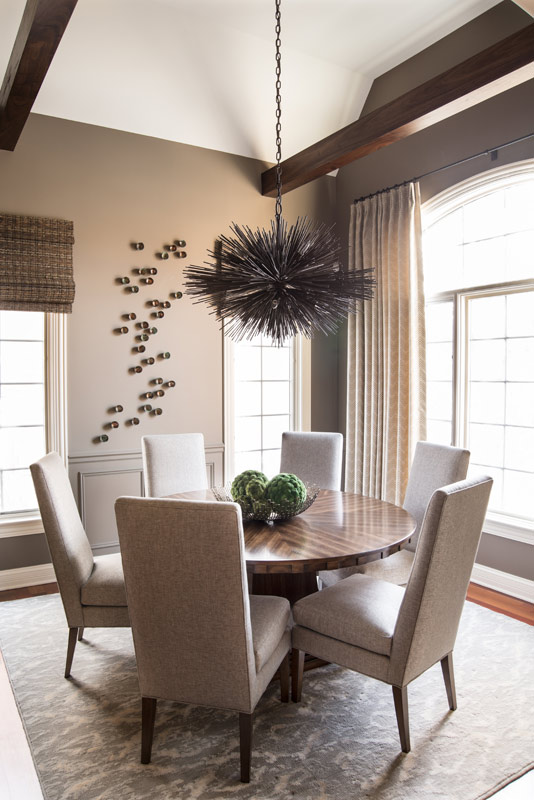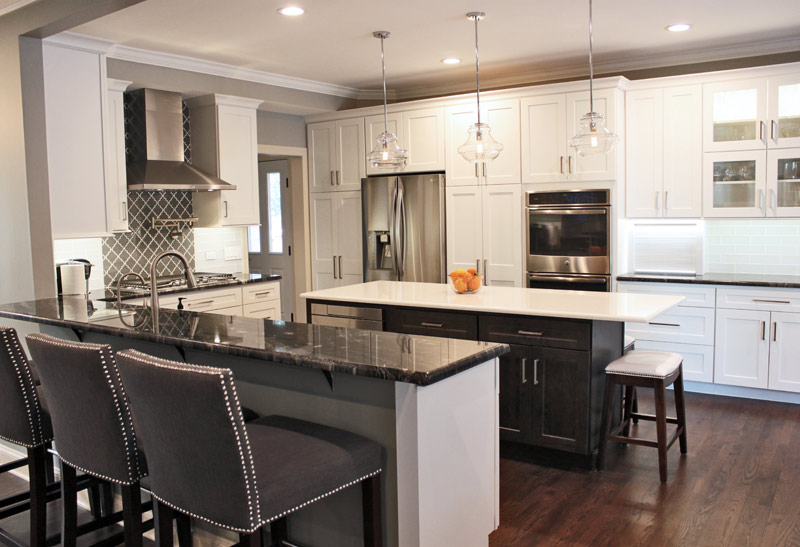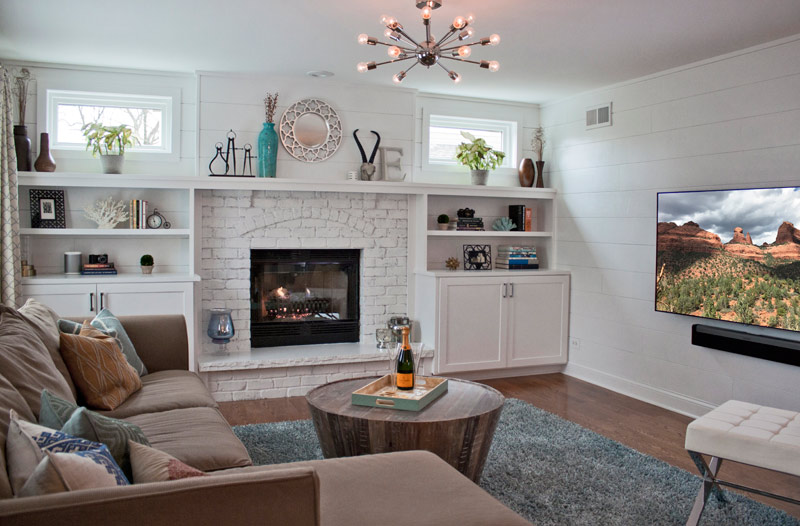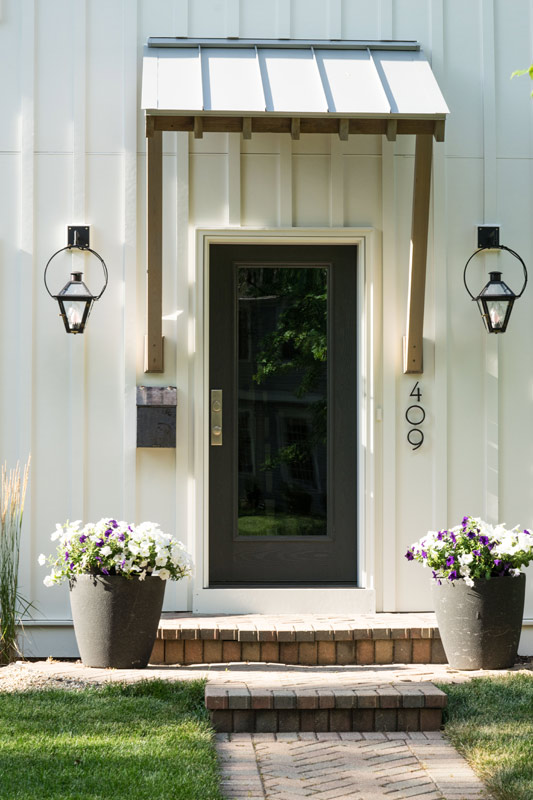Modern Love—Choose Smart Midcentury Updates that Work with Your Home
By Kari Richardson
September 2017 View more Featured
 By Kari Richardson
By Kari Richardson
Midcentury modern design is having another big moment. The style, which first became popular in architecture and interior design circles during the 1950s and ’60s, is known for its use of clean lines and organic shapes, as well as for its emphasis on texture and pairing of industrial and natural materials.
Hinsdale-based architect Patrick Fortelka is seeing more requests for modern design in his practice. He’s now completing architectural plans for redesigns of three vintage homes.
“It’s a sort of rebirth of the midcentury,” says Fortelka, co-owner of Moment Design with Raynette Bradford. “There’s a new appreciation for this style.”
But classic modern design isn’t just for edgy new construction in urban areas or for those who snap up a vintage home. Elements of this style can also pair nicely with the architecture found in more traditional homes.
“It’s about clean lines and keeping things simple,” says Kristin Petro, principal of Elmhurst-based Kristin Petro Interiors. “There are ways to introduce these elements into any decor.”
While some clients worry that embracing modern design will make their living spaces feel cold and sterile, Petro has found otherwise. “You can introduce these elements and be super comfy and cozy,” she says.
Ready for a refresh but uncertain how to channel this classic style? Read on for expert advice on giving your spaces some modern snap.
 Kitchen
Kitchen
Range hoods are a focal point in many kitchens. If your kitchen has one, you might choose a sculptural stainless steel version, suggests Chad Esslinger, designer and principal of Chad Esslinger Design in Downers Grove.
“The right hood vent gives the kitchen a dramatic feeling,” he says.
Many of the clients he works with have young families and are moving from city to suburbs. They are looking to blend a modern aesthetic with the traditional homes they are buying, he says.
Cabinetry can be expensive to replace in a traditional home, but a textured backsplash is a more budget-friendly update that makes a big impact.Esslinger likes to arrange monochromatic tile in a herringbone or chevron pattern.
Subway tile is a low-key classic and a popular choice for backsplashes rich in texture, says Janice Teague, senior designer with Glen Ellyn–based Drury Design. New sizes of the material, such as 4- by 12-inch and 9- by 12-inch tiles, give the look a fresh twist.
Countertops, another key element, are now available in new materials and styles that pair well with this aesthetic. Honed or satin countertops have less movement than other styles and a more understated look. If granite is your countertop of choice, consider a more subdued brushed or leathered finish. Natural wood countertops are also gaining popularity, particularly on islands, where they can be used as surfaces for chopping and preparing food, Teague says.
Another quick, inexpensive fix is an update of existing light fixtures. Replace a traditional candelabra with something in an organic shape such as a sphere, or use minimalist bar-shaped lighting.
 Living Areas
Living Areas
Designer Lauren Fasolo, owner and principal of Naperville’s Ellce Designs, likes to begin projects with a clean palette: Existing hardwood floors can be sanded and stained a more desirable shade, trim and doors refreshed with paint. Light gray and sandy-colored doors are gaining popularity with clients, she says. Traditional homes often have crown molding and elaborate trim. To adopt a less fussy style, minimize the look by painting molding the same color as the wall.
Choose simple window treatments that work with classic elements you want to preserve. In Fasolo’s own home, that includes six-panel doors, a brick fireplace and built-in bookshelves. In these areas, too, lighting—from table and floor lamps to hardwired fixtures—is an easy update that can be fairly inexpensive for the impact it makes.
Petro also helps clients strike the right balance by choosing which elements to update and which to preserve. That might mean pairing a favorite traditional rug with a new sofa in a modern shape. “Sometimes it’s as simple as taking away more than you add,” she says.
Consider mixing in midcentury furniture pieces. Although it’s getting more difficult to scoop up vintage pieces at affordable prices, reproductions can be found at a variety of price points. Just make sure the new design element appears in at least three different places or it will appear to be unintentional, Petro says.
Bathrooms
While bathrooms are often overlooked, they can be one of the most visible areas of the home to guests and are also worthy of a modern update.
To streamline a bath and create an airy feeling, Esslinger likes to use wall-mounted toilets and vanities. A favorite bath he recently designed featured a wall-mounted vanity with a vessel sink.
“I always encourage people to do something dramatic in a bathroom,” Esslinger says, adding that the room’s separation from the rest of the house makes it a natural place to try something new.
His suggestions include painting the room a bold color, displaying an eye-catching piece of artwork or adding wallpaper. While some clients associate wallpaper with traditional homes, Esslinger says they are surprised by new designs, which are sleek and minimalist.
Another modern touch: changing up tile. Large-scale versions give a seamless look, particularly when they appear throughout the space, Petro says. And, if you are lucky enough to have room for a freestanding tub, consider a sculptural version as a focal point for the room.
 Exterior
Exterior
Along with vertical siding and metal roofs, glass is key to many of Fortelka’s designs. Oversized windows and walls of glass invite the outside in, another important element of midcentury design.
Fortelka recently worked with Fasolo on a redesign of her family’s home, a four-square Colonial in Naperville’s Saybrook subdivision. Fasolo wanted to ensure that her home meshed well with other homes in the 1960s-era neighborhood, while at the same time creating a distinct new appearance.
The contemporary farmhouse they created together has contrasting elements: A light-colored, board-and-batten siding was chosen for the previously existing part of the home, while the addition is set apart with tongue and groove siding.
“You can clearly see the older Colonial structure, but it’s cleaned up, simpler and not fussy,” Fasolo says.
It now matches her home’s interior, which she’s been injecting with updated elements for several years. For the Naperville designer, it’s modern love.


